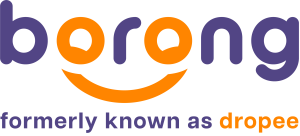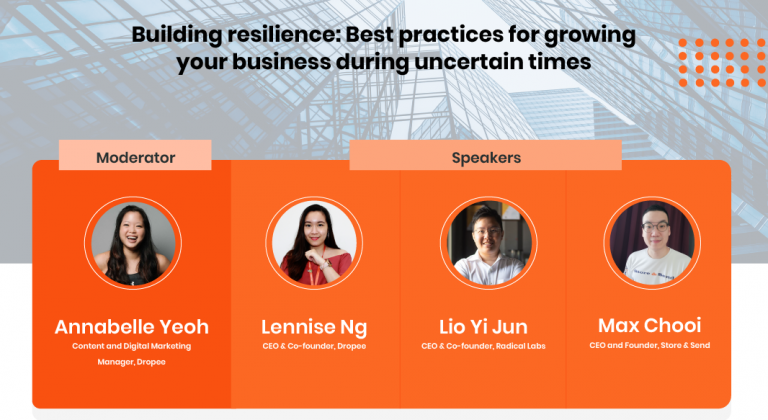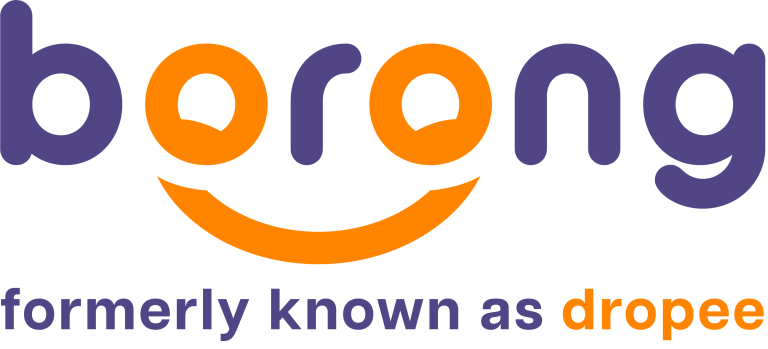“2020 has been the year for us to realise that change doesn’t happen overnight unless it is necessary. And right now, innovation is absolutely necessary,” said Lennise Ng, CEO and co-founder at Dropee.
Almost a year into Covid-19, with its impact felt across industries, it’s clear that digitisation is the way forward. But digitisation is a big word, and for many SMEs who are new to the landscape, it can feel daunting.
How can businesses forge ahead – especially when times are still uncertain?
In collaboration with MATRADE, Dropee launched its first-ever webinar to answer this question.

Joined by Lennise Ng, CEO and co-founder at Dropee, Lio Yi Jun, co-founder at Radical Labs and Max Chooi, founder and CEO of Store & Send, Building Resilience: Best Practices for Growing Your Business Amidst Uncertainty shared how businesses can forge ahead by turning this crisis into a key opportunity.
Encik Hadi, Director of Transformation and Digital Trade of MATRADE, kick-started the webinar with an opening speech.
To boost the domestic economy, he shared that the nation is encouraging SMEs to take on digital transformation initiatives. With SMEs making up 98.5% of businesses in Malaysia, it’s important for them to be given the right opportunities and support.
For decades, MATRADE has helped many SMEs go global – and the organisation continues its efforts with the launch of the ETRADE programme. ETRADE promotes the adoption of e-commerce among Malaysian companies to accelerate exports through participation in international e-commerce platforms.

The Malaysian government has recently approved for the programme to continue running in 2021, which is welcoming news for local businesses.
Right after, Annabelle Yeoh, the webinar’s moderator, dived right into the session.
“The businesses who thrive the most are the ones that make quick decisions on going digital.”
Lennise Ng, CEO and co-founder at Dropee
Adapting in Today’s Landscape
The webinar addressed a highly anticipated question on everyone’s mind: how can businesses adapt in today’s online landscape? For Lennise, speed is key.
“At Dropee, we noticed that the businesses who thrive the most are the ones that make quick decisions on going digital.”
She highlighted an example from an MNC company, where there are typically SOPs to adhere to and long approval processes.
But with sales at a record low, they had to react – fast. So in less than two weeks, the company adopted Dropee’s solution, and successfully continued operations.
As for Max from Store & Send, he encouraged clients to look at strengths and weaknesses. “Continue doing what you do best”, he said, but for weaknesses, “acknowledge that it’s never about what you don’t like to do, it’s what you can’t do on your own”.
Yi Jun from Radical Labs, too, emphasised the importance of identifying key partners and leveraging their expertise.
“When it comes to digitalisation,” he added, “it’s not just about e-commerce. It’s also about transforming your business processes.”
But for an SME, wouldn’t transformation mean a 360 change? Not necessarily.
Bridging Online and Offline
“Going digital is not about adopting a full system,” said Lennise. “It’s about bridging offline and online.”
She recommends businesses to look into the key areas that affect their sales, and bring them online with the main goal of better engaging with customers.
One way is to spend some time and resources to analyse data revolving around customers. Then, comes the important bit: tracking.
“We don’t know what we don’t know,” she reiterated. “Talking to your customers on WhatsApp, one by one, is not efficient. Your data is not being tracked and traced. Without it, you cannot understand what your customers are asking you, what problems they are facing, and how you can better offer your solutions.”
Often, implementing automated solutions is quicker and more cost-efficient.
Max agreed and called for businesses to do a comparison between manual processes and automation. The results are clear, as the latter can do the job more efficiently and accurately.
Be Precise on Your Goals
With that said, it’s important for businesses to be clear on where technology can help. Without a clear picture of what areas to digitise, the custom requests can overflow, making it hard to mobilise or go live in time.
In Lennise’s words: “It’s a lose-lose situation – you’re not just wasting time, which is the most expensive thing to waste right now (remember, speed is key!), you’re also wasting resources which could have been used for something more important.”

Yi Jun, too, recalled a story of how a huge company paid for software with heavy customisation – only for them to use a very small part of it.
For Max, it was his own business that experienced the situation above. They’ve adopted a Warehouse Management System (WMS) once, and it cost them more time.
“You have to know what’s required on your end. Don’t go for fancy names, go for what solves your problems.”
Lennise wrapped it up with a brilliant metaphor: “You don’t need to own a Ferrari to move from point A to point B, the actual thing you need is just a mode of transportation.”
Key Takeaways
As the webinar draws to a close, each panelist shared what businesses can expect going forward into 2021 – and it boiled down to keeping up with changing times.
“Your customers are demanding more,” said Lennise. “There will be new expectations, and you have to be the platform to tell them what they want.”
To watch the full webinar, click on the Building Resilience: Best Practices for Growing Your Business Amidst Uncertainty link!


